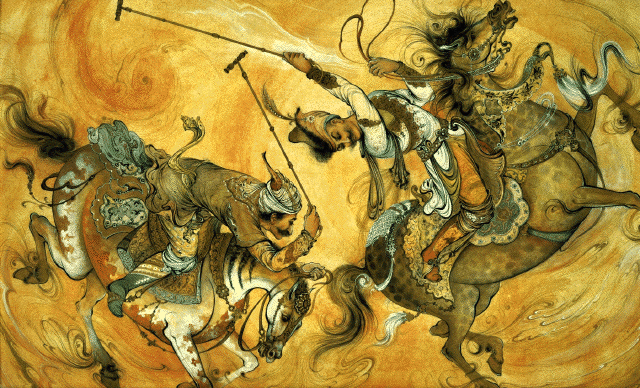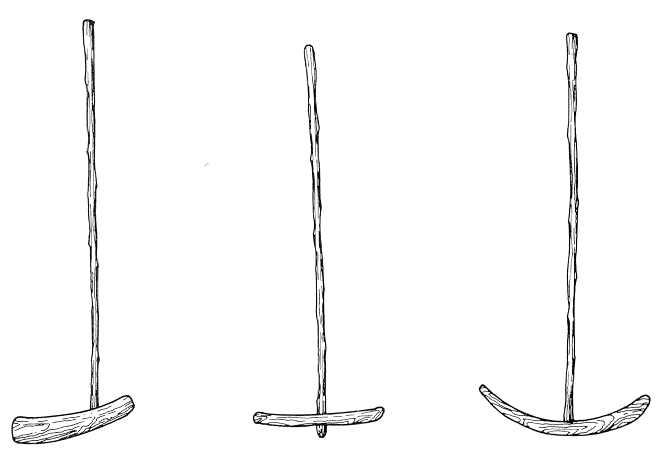

Circle of Ancient Iranian StudiesHISTORY OF CHOGÂN (POLO)Edited by Shapour Suren-Pahlav  "Let other people play other things - the king of game is still the game of kings" This verse is inscribed on a stone tablet next to a polo ground in Gilgit, north of Kashmir, near the fabled silk route from China to the West. In one ancient sentence it epitomises the feelings of the players today. Polo is arguably one of the most complex of games in the world. The precise origin of polo is obscure and undocumented and there is ample evidence of the game's regal place in the history of Asia. No one knows where or when stick first met ball after the horse was domesticated by the ancient Iranian (Aryan) tribes of Central Asia before their migration to Iranian plateau; but it seems likely that as the use of light cavalry spread throughout Iranian plateau, Asia Minor, China and the Indian sub-continent so did this rugged game on horse back. However, many scholars believe that polo originated among the Iranian tribes sometime before the reign of Darius the Great (521-485 BCE) and his cavalry forged the Second Iranian Empire, the Achaemenid dynasty. Certainly it is Persian literature and art, which give us the richest accounts of polo in antiquity. Ferdowsi, the most famous of Iran's poet-historian, gives a number of accounts of royal polo tournaments in his 9th century epic, Shâhnâmeh (the Epic of Kings). Some believe that the Chinese (the Mongols) were the first to try their hands at the game, but in the earliest account, Ferdowsi romanticizes an international match between Turanian force and the followers of Syavoush, a legendary Persian prince from the earliest centuries of the Empire. The poet is eloquent in his praise of Siyâvash's skills on the polo field. Ferdowsi also tells of Emperor Sâpour-II of Sasanian dynasty of the 4th Century CE, who learn to play polo when he was only seven years old. Another 9th century historian, Dinvari, describes polo and its general rules and gives some instructions to players including such advice as 'polo requires a great deal of exercise', 'if polo stick breaks during a game it is a sign of inefficiency' and 'a player should strictly avoid using strong language and should be patient and temperate'. During the 10th century the Iranian King Qâbus of Ziyarid (Ziyâriân) dynasty, also set down some general rules of polo and especially mentioned the risks and dangers of the game. The best-known references to polo in Persian poetry are from the Rubâiyâts of Omar/Umar Khayyâm. He uses polo to illustrate philosophical points. Also there are many of the Persian manuscripts in which these references appear are beautifully illustrated with miniatures depicting royalty and their best horsemen playing polo. The 13th century common era, Iranian poet Nezâmi (1126-1180), weaves the love story of the Sasanian Emperor Khosrow II Parviz (590CE) and his beautiful consort Shirin, around her ability on the polo field, and describes matches between the Emperor and his courtiers and Shirin and her ladies-in-waiting. Polo has became popular among other nations such as Chinese, as was the royal pastime for many centuries. Chinese most probably having learned the game from the Iranians nobilities who seek refuge in Chinese courts after the invasion of Iranian Empire by the Arabs, or possibly by same Indian tribes who were taught by the Iranians. The polo stick appears on Chinese royal coats of arms and the game was part of the court life in the golden age of Chinese classical culture under Ming-Hung, the Radiant Emperor, who as an enthusiastic patron of equestrian activities. Less cultured, one might think, was the reaction of Emperor Tai Tsu in 910 CE. who according to one source, ordered all the other players beheaded after a favourite was killed in a match. The Japanese learnt polo from the Chinese, while across the Continent the game spread as far West as Egypt, with the Arab conquests of the Iran beginning in the 7th century. The game occupied an exhaulted place in Islamic court life, Haroon-al-Rashid being the first of the Abbasid Caliphs to play. The polo stick was an important motif in Islamic, was well as Chinese, heraldry, and the Jukandar Polo Master, was a well-known official in the Caliphs's entourage. It seems strange that the Crusaders did not take polo back to Europe with them, but the game did reach Constantinople under the Byzantines. The 12th century ruler, Manual I Commenos was a patron of polo and it is recorded that one of his successors Emperor Hohannes Chinnasus, played until his leg and arm were crushed in a bad fall during match. The Muslim conquerors also took the game eastward with them, to the Indian subcontinent where it was played by the Muslim rulers and adopted by local Kings and Princes as well. In a dusty, back alley near Anarkali Bazar in Lahore stands a monument to Sultan Qutabuddin Aibak, a 13th century King who died when his pony fell during a polo match. It was about this time that the hordes of Changiz Khan swept down from the North to conquer all the Iranian realm and Asia Minor. If his followers had not already played the game, they certainly learnt it from the Iranians. One legend has it that Timurlane, a descendent Changiz, once ordered his cavalry to play polo with the heads of their captives. When a follower of Timurlane, Baber, founded the Mughal Empire in India in the 16th century, he played polo and established it as the most popular of royal sports for his successors. Akbar was especially found of the game, sometimes playing at night by torchlight. His vast stables, which can still be seen near Agra, housed his favourite polo ponies. The most spectacular tribute to polo in antiquity is a city laid out around a Kings Polo Ground. Towards the end of the 16th century, the capital of the Safavid Empire was moved to Esfahân from Qazvin, and Shah Abbâs the Great decided to redesign the city to make it the most beautiful in the world. He planned his city around a vast, central square, the Maydân-e-Shah or Naqsh-e Jahân. The maydân, which served as the royal polo ground, was about 500 yards long and 150 yards wide and at each end were stone goal posts eight yards apart, which is today the regulation width of a polo gal. At approximately midfield the Shah built a seven-story palace, Âli-Qâpu. As the central feature of the palace his architects designed a towering royal gallery, its roof supported by 18 graceful, wooden columns. At the south end of the field just beyond the goal posts Shah Abbas constructed the magnificent Masjed-Shah, whose mosaic domes and minarets make it one of the most beautiful in the World. Beyond the northern goal is the elaborately decorated Qaysariya Gateway leading to the Royal Bazaar. The stone goal posts, as well as the palace, the mosque and the bazaar can still be seen today, although ornamental pools and gardens have replaced the field where ponies galloped and mallets flayed centuries ago. The Bazaar in Esfahan offers, in addition to the normal wares of an Eastern market, an astonishing variety of souvenirs decorated with old polo scenes copied from Persian miniatures. One can note at sites like Esfahan and in ancient art and literature certain differences in polo of past centuries and the game as we know it today. The fields were often longer and narrower. Teams were frequently much larger than the four-a-side standard of today. The game was sometimes started with the ball placed at midfield and the two teams charging one another from opposite ends; sometimes the ball was thrown into the air and hit towards goal to start a match. Mallets were of shapes, which would appear curious to the players of today. In Japan and in Byzantium, the sticks carried racquet heads rather than mallet heads and a leather-covered ball was used.  For more than 20 centuries polo remained a favourite of the rulers of Asia, who played the game or were its patrons. Their Queens played, as did the nobility and the mounted warriors. Polo for non-Iranians was the nearest equivalent to a national sport in those times, from Japan to Egypt, from India to Byzantium. As the great Eastern Empires collapsed, however, so disappeared the glittering court life of which polo has been so important a part, and the game itself was preserved only in remote villages. Gilgit in Kashmir, is such a village, situated between the great Karakoram Range and the Hindu Khush north of Kashmir. Here one can still watch polo as it was played centuries ago. The absence of a King's court the polo scene at Gilgit could be taken straight from Persian miniatures. |